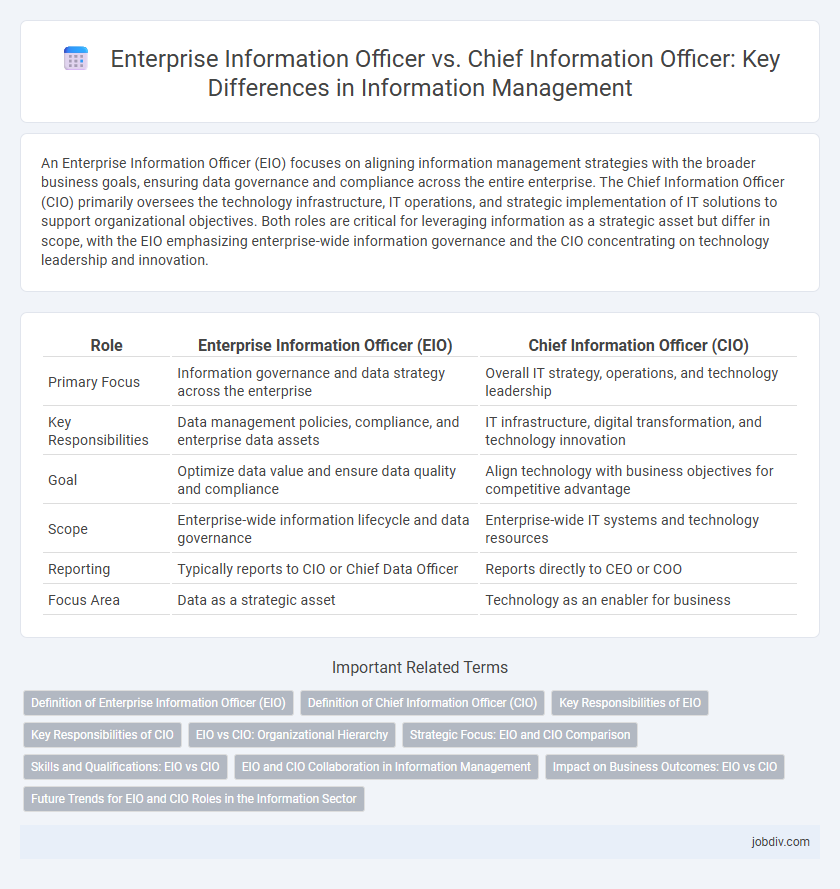An Enterprise Information Officer (EIO) focuses on aligning information management strategies with the broader business goals, ensuring data governance and compliance across the entire enterprise. The Chief Information Officer (CIO) primarily oversees the technology infrastructure, IT operations, and strategic implementation of IT solutions to support organizational objectives. Both roles are critical for leveraging information as a strategic asset but differ in scope, with the EIO emphasizing enterprise-wide information governance and the CIO concentrating on technology leadership and innovation.
Table of Comparison
| Role | Enterprise Information Officer (EIO) | Chief Information Officer (CIO) |
|---|---|---|
| Primary Focus | Information governance and data strategy across the enterprise | Overall IT strategy, operations, and technology leadership |
| Key Responsibilities | Data management policies, compliance, and enterprise data assets | IT infrastructure, digital transformation, and technology innovation |
| Goal | Optimize data value and ensure data quality and compliance | Align technology with business objectives for competitive advantage |
| Scope | Enterprise-wide information lifecycle and data governance | Enterprise-wide IT systems and technology resources |
| Reporting | Typically reports to CIO or Chief Data Officer | Reports directly to CEO or COO |
| Focus Area | Data as a strategic asset | Technology as an enabler for business |
Definition of Enterprise Information Officer (EIO)
The Enterprise Information Officer (EIO) is a senior executive responsible for overseeing the management, governance, and strategic use of an organization's information assets. Unlike the Chief Information Officer (CIO), who focuses primarily on IT infrastructure and technology deployment, the EIO emphasizes enterprise-wide data quality, information policies, and compliance. The EIO ensures that information serves as a strategic asset, driving business decisions and operational efficiency across all departments.
Definition of Chief Information Officer (CIO)
The Chief Information Officer (CIO) is a senior executive responsible for managing and implementing information technology strategies aligned with an organization's business goals. The CIO oversees IT infrastructure, ensures cybersecurity, and drives digital transformation initiatives to enhance operational efficiency. Unlike the Enterprise Information Officer, the CIO typically focuses on the overall technological direction and innovation within the company.
Key Responsibilities of EIO
The Enterprise Information Officer (EIO) primarily focuses on overseeing the strategic management of an organization's data assets to ensure accurate, accessible, and secure information flow across all departments. Key responsibilities include developing enterprise-wide information policies, coordinating data governance frameworks, and driving initiatives that enhance data quality and compliance with regulatory standards. In contrast, the Chief Information Officer (CIO) typically has a broader role encompassing overall IT strategy, infrastructure management, and technology innovation beyond data governance.
Key Responsibilities of CIO
The Chief Information Officer (CIO) primarily oversees the overall technology strategy, aligning IT initiatives with business objectives to drive digital transformation and innovation. Key responsibilities include managing IT infrastructure, ensuring cybersecurity, and leading the development of data governance policies to optimize information management. The CIO also spearheads cross-departmental collaboration to enhance operational efficiency and support scalable growth across the enterprise.
EIO vs CIO: Organizational Hierarchy
The Enterprise Information Officer (EIO) typically operates within a higher organizational tier than the Chief Information Officer (CIO), overseeing the entire information management strategy across all business units. EIOs focus on aligning information governance with corporate objectives, while CIOs primarily manage IT infrastructure and operational technology. This hierarchical distinction positions the EIO as a strategic leader driving enterprise-wide information policies, whereas the CIO ensures effective technology deployment and service delivery.
Strategic Focus: EIO and CIO Comparison
Enterprise Information Officers (EIOs) prioritize aligning information management with enterprise-wide business goals, emphasizing data governance and operational efficiency. Chief Information Officers (CIOs) focus on strategic technology innovation, digital transformation, and IT infrastructure to drive competitive advantage. Both roles are integral for organizational success but differ in scope, with EIOs leaning towards enterprise-wide information strategy and CIOs concentrating on technology leadership.
Skills and Qualifications: EIO vs CIO
Enterprise Information Officers (EIOs) require strong expertise in data governance, enterprise architecture, and cross-departmental information integration to align IT initiatives with business strategies. Chief Information Officers (CIOs) focus on strategic leadership, technological innovation, and operational management, emphasizing skills in IT budgeting, vendor management, and digital transformation. Both roles demand advanced qualifications in information technology, business administration, or related fields, often supported by certifications such as PMP, CISSP, or ITIL.
EIO and CIO Collaboration in Information Management
Enterprise Information Officers (EIOs) and Chief Information Officers (CIOs) collaborate closely to optimize organizational information management by aligning data governance, technology strategy, and business objectives. EIOs specialize in managing enterprise-wide data quality, compliance, and lifecycle processes, ensuring information assets are reliable and accessible. CIOs focus on IT infrastructure and innovation, enabling the EIO's data initiatives through technology integration, cybersecurity, and digital transformation efforts that drive enterprise value.
Impact on Business Outcomes: EIO vs CIO
Enterprise Information Officers (EIOs) focus on aligning information management strategies with operational efficiency, directly enhancing business outcomes through improved data governance and analytics. Chief Information Officers (CIOs) drive broader IT innovation that fosters competitive advantage and digital transformation, impacting revenue growth and market positioning. The strategic collaboration between EIOs and CIOs ensures comprehensive information utilization, optimizing business performance and decision-making processes.
Future Trends for EIO and CIO Roles in the Information Sector
Enterprise Information Officers (EIOs) and Chief Information Officers (CIOs) are evolving to prioritize advanced data analytics, artificial intelligence integration, and cybersecurity enhancements to meet future information sector demands. The EIO role is increasingly centered on managing enterprise-wide information asset governance and leveraging big data for strategic decision-making. CIOs will focus on driving digital transformation initiatives, optimizing IT infrastructure for cloud and edge computing, and fostering innovation to maintain competitive advantage in rapidly changing technological landscapes.
Enterprise Information Officer vs Chief Information Officer Infographic

 jobdiv.com
jobdiv.com